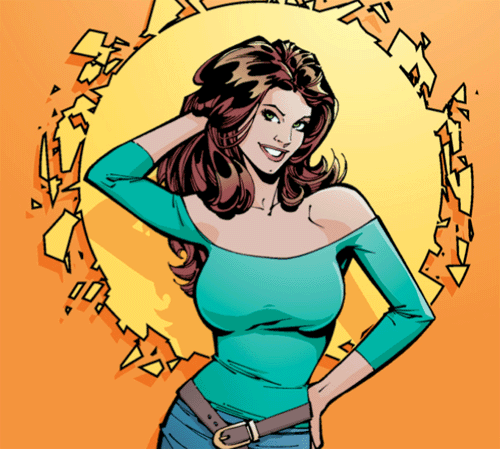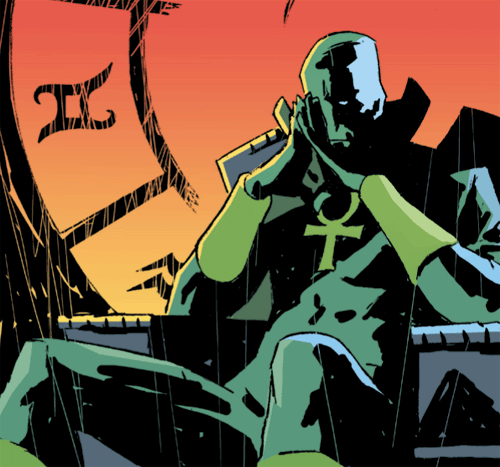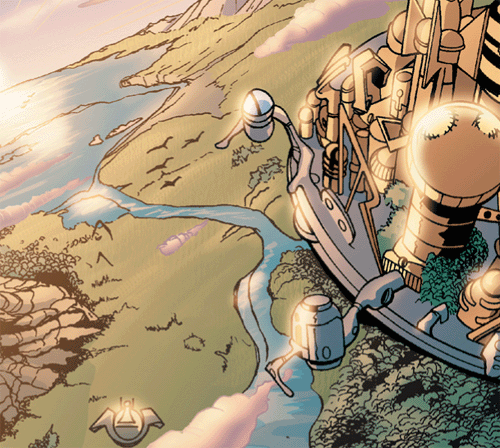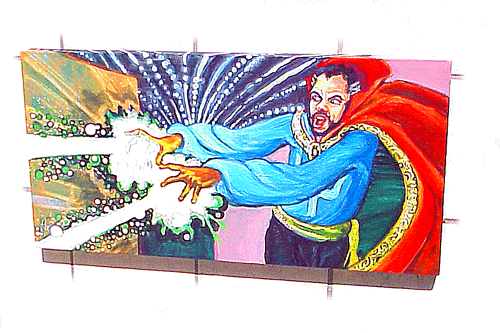You may have noticed in my previous columns that I often focus on ethereal subjects and themes. A friend once shook his head at me and said, “One thing about you . . . things are never mundane.” Whether this is seen as a flaky otherworldliness or a direct rebuff of consensus reality, it is surely a non-physical locus of operations.
Matter confines us to the Earth. Our bodies are subject to the undeniable laws of physics. And yet, most of our lives are lived in a non-physical construct of ideas and imagery. Some of our lives are spent inside the world of Vs. System.
Today’s presentation will concern itself with the ways in which the physical and non-physical interact in our game. Let’s start at the beginning.
1. The Human Body
I am inside my body while I am writing this. My brain is forming the strings of words, and then my fingers are typing them on the keyboard while my eyes are directing the show. I just got an itch on my arm and I scratched it with my fingernails. It felt good. The concept of good is totally non-physical. I remember being very young and setting the air-conditioning icy cold before taking a steaming hot bath. The physical pleasure I received made me understand the vividly vibrant value of a purely physical phenomenon.

While Vs. System may not provide much in the way of a direct physical stimulus, it does require a modicum of material manipulation. In order to compete, each player must transport his or her body to the assigned area for the tournament. Official physical copies of the cards must be shuffled and drawn and placed on an actual table. Playing online allows a suspension of the limits of geography, but still requires physical control of electronic equipment to send the signals into virtual space. So far, the human body is still a required tool for playing the game.
2. A Medium for Symbols
I wrote a novel once about a love story that occurred both in and out of physical reality. For the couple that could survive the jump, the one thing they were most amazed at was the way humans communicate. Certain squid do it, too. A set of eyes receives a picture. The image is translated into a symbolic pattern that triggers memory and anticipation. The creature that is using the set of eyes reacts. Sometimes the reaction is so drastic that it shifts the entire consciousness of the animal that is receiving the signal. Words and pictures can control chemical content in the human body very easily. Physical status can be changed drastically by non-physical input.

Vs. System is a set of symbols beautifully printed on trading cards. The competition takes place in a non-physical strategic battleground populated by comic book characters that are represented within small plastic sleeves on the solid wood of the gaming table. Some game-related information is in numerical form and some is written text. Mythological meaning is contained within each card. This iconography takes the form of an established fictional name when it identifies a character or location. Plot twists represent more generic symbols that can be applied to a large number of situations, both in legend and in real life. The artwork on each card adds another dimension to the symbolism, as well as a great deal more non-physical pleasure.
3. An Imaginary Cosmos
The gray matter in the human brain has the capacity to create endless imaginary objects and actions. Since these non-physical constructions have the potential to affect us deeply in real life, we often imagine them to be palpable presences. If we believe in metaphysical forces strongly enough, they actually seem to work on the physical things around us. The human mind delights in allowing itself to “prove” the existence of non-physical realities, either through wish fulfillment or self-delusion.
If we were living in ancient Greece or Rome, we would experience our imaginary entities as actual beings. Our modern mythos is not considered factual or physical very often. There are not many Vs. System players who truly believe in the existence of New Genesis, although there are some. For them, it is real. For everyone else, it is a metaphor and a touchstone to a tendency in the human experience. It is a way to share our lives with others, using the non-physical language of comic mythology.

For the fans of such things, Vs. System provides a physical reminder of the power of their cherished non-physical entities and environments. Enthusiast and expert extraordinaire Robert “Bizarro #98” McSantos was gushing on the forums the other night about his list of favorite locations and the chance to add a few more in the upcoming Heralds of Galactus set. He surely does not believe in the physical reality of these places. That does not mean that his life is not changed by their existence, both in the historical comics and on the cardboard of Vs. System. Here are Bizarro #98’s most beloved places, followed by an explanation of their non-physical hold on him:
Anti-Matter Universe
Apokolips
Bizarro World
Empire of Tears
Fifth Dimension
Korugar
Mogo
Mojoverse
Mosaic World
Negative Zone
New Genesis
Oa
Orinda
Phantom Zone
Prison Planet
Qward
Rann
Tamaran
Thanagar
Warworld
I’ve always been a big fan of the sci-fi aspects of comics, so I like to collect location cards of planets and alternate universes. Aliens are some of the best comic book characters because their inhumanity can provide entertaining contrasts for the reader.
What I like about location cards that represent alien planets and alternate universes is how they always tell you a little something about their inhabitants. For example, the pure-hearted New Gods are a selfless people who always seek to help those in need, so their world, New Genesis, allows you to recover stunned characters. The Qwardians, on the other hand, have a reversed concept of morality, so their planet, Qward, rewards you for bringing your opponent’s characters down instead of picking your own up. The Manhunter robots sought to keep their existence a secret and to convince the rest of the universe that they were only a myth, so their adopted home world, Orinda, allows you to hide your Manhunters safely out of sight. The Rannians and the Thanagarians are two alien races who have become bitter enemies, which is why Rann and Thanagar cannot be played at the same time.
Worlds like these that are so different from Earth are really fun settings for all kinds of different stories. I’m glad I get to rule over them in cardboard form. I look forward to adding Hala and Skrullos to my collection.
Although our culture’s superheroes are not considered real anymore, many comic book fans become physically agitated when their favorite character histories are misrepresented in public. Both Marvel and DC Comics have recently started catering to this obsession by publishing “official canon” statements—as if their non-physical stories had occurred in physical history. It is a fabulous and fascinating phenomenon that has accompanied the full flowering of the artistic accomplishments of the comic book and its creators.

Our mythological legends have such a strong hold over our brains that fans of Vs. System’s imaginary character cosmos took part in a wildly popular fantasy election over the last two weeks. Players from all over the world voted for the best character card at each recruit cost to choose the Curve of Death. The ballots have been cast and the results have been tabulated. The winners will be announced at the end of this article, whether they exist in physical form or not.
4. Real Magic
The presence of luck in a game of Vs. System can neither be denied nor avoided. If there were a non-physical mechanism for adjusting fortunate draws, it would be very beneficial. Rabbits’ feet and lucky kisses might honestly work, but they cannot be proven. That’s where Dr. Strange comes in.

Stephen Strange was a surgeon. He was very good, and he was very famous for it. His skills were purely physical; he had the best hands in the business. Then his luck ran out. A terrible accident destroyed his fingers and snatched away the life to which he had grown accustomed. He was crushed by the weight of it.
The bondage of his physical handicap drove him to the brink of insanity. It also drove him into the mountains of Tibet. There he met a master of non-physical manipulation—a wizard of the highest order named the Ancient One. Stephen Strange learned to use something other than his hands to pick things up. He learned real magic. Again, he was very good, and he became the Earth’s Sorcerer Supreme. Dr. Strange would be very good at Vs. System.
We have a Dr. Strange character card from the Marvel Knights set. He can move any number of characters to the hidden area by transporting them in and out of the physical state. This is a very strong ability, but it did not earn a spot in the Curve of Death. Dr. Strange can hold himself in an astral state of being and remain non-physical for nearly twenty-four hours in the comic myths. This was not enough to get him elected.
5. Concerted Effort
If there is one thing you remember from this class, I hope it is this: magic does not happen without effort. This is true for non-physical effects, as well. If you want it to work, then work on it. There are over twenty different players in this game who have already won over $12,000 each playing Vs. System. They did not sit back and wait for it to happen.
I wanted the Curve of Death to happen. Together, we made it work. Hundreds of ballots were cast, just like tiny non-physical spells. The fans have spoken. Here are the results.
Curve of Death 2006, with final vote totals
1-drop: Alfred Pennyworth 62%
2-drop: Poison Ivy, Deadly Rose 38% and Beetle, Armorsmith 36%
3-drop: Dr. Light, Master of Holograms 76%
4-drop: Dr. Doom, Diabolic Genius 93%
5-drop: Garth 95%
6-drop: Bastion 32% and Sinestro, Green Lantern of Korugar 32%
7-drop: Spider-Man, The Amazing Spider-Man 54%
8-drop: Jean Grey, Phoenix Force 33% and Apocalypse 30%
9-drop: Onslaught 82%
10-drop: Imperiex 96%
Three of the races were too close to call. We will not conduct a run-off. The throne will be shared at 2, 6, and 8. My mistaken placement of Apocalypse above his 8-drop status was quickly corrected from all over the world by remote control. The 9- and 10-drop slots were not included on the original ballot but scores of readers demanded them. They persuaded me properly without ever laying a finger; non-physical manipulation was achieved. The Curve of Death can be an annual event; we will vote again on July 4, 2007. Will there be worthy new challengers? Will the balance of power shift to break the ties? Only time will tell, even if we cannot touch it.
Rian Fike is also known as stubarnes and this article was inspired by a non-physical request via email. If you want to help guide him into the future from right where you are sitting, send suggestions to rianfike@hattch.com.